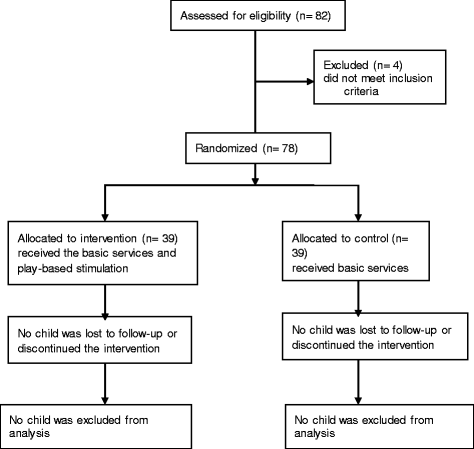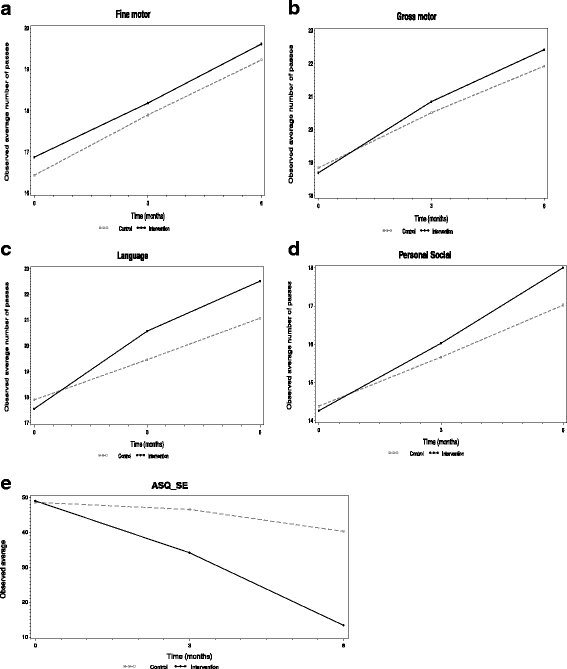Effects of home-based play-assisted stimulation on developmental performances of children living in extreme poverty: a randomized single-blind controlled trial
- PMID: 29402258
- PMCID: PMC5800292
- DOI: 10.1186/s12887-018-1023-0
Effects of home-based play-assisted stimulation on developmental performances of children living in extreme poverty: a randomized single-blind controlled trial
Abstract
Background: Children living with foster families in a resource-limited setting such as Ethiopia are at risk of developmental problems. It is not yet clear whether intensive home-based developmental stimulation assisted by play can reduce these problems. The main objective of this study was to examine the effects of play-assisted intervention integrated into basic services on the developmental performance of children living with foster families in extreme poverty.
Methods: A randomized single-blind (investigator) controlled trial design was used. The study was conducted in Jimma, South West Ethiopia. Using computer-generated codes, eligible children of 3-59 months in age were randomly allocated to intervention (n = 39) and control (n = 39) groups at a 1:1 ratio. Children in the intervention group received home-based play-assisted stimulation in addition to the basic services provided to children in both groups. The intervention consisted of an hour of play stimulation conducted during a weekly home visit over the course of six months. Personal-social, language, fine and gross motor outcomes were assessed using Denver II-Jimma, and social-emotional outcome was obtained using an adapted Ages and Stages Questionnaire: Social-Emotional (ASQ: SE). Information about sociodemographic characteristics was collected using a structured questionnaire. Anthropometric methods were used to determine nutritional status. The effects of the intervention on the abovementioned outcomes over the study period and group differences in change over time were examined using Generalized Estimating Equations (GEE).
Results: Statistically significant intervention effects were found for language (P = 0.0014), personal-social (P = 0.0087) and social-emotional (P < 0.0001) performances. At the midline of the study, language (effect size = 0.34) and social-emotional (effect size = - 0.603) benefits from the play-assisted stimulation had already been observed for the children in the intervention group. For language, the intervention effect depended on the child's sex (P = 0.0100) and for personal-social performance, on family income (P = 0.0300).
Conclusions: Intensive home-based play-assisted stimulation reduced the developmental problems of children in foster families in the context of extreme poverty. Longer follow-up may reveal further improvements in the developmental performance of the children.
Trial registration: The study was retrospectively registered on ClinicalTrials.gov on 17 November 2016, Study Identifier: NCT02988180 .
Keywords: Developmental performance; Developmental stimulation; Extreme poverty; Foster family; Home-based; Play-assisted stimulation.
Conflict of interest statement
Ethics approval and consent to participate
Study approval was obtained from The Institutional Review Board (IRB) of Jimma University, Ethiopia (Date: 13-02-2013, Number: RPGC/36/2013) and The Ethical Committee or ‘Comite voor Medische Ethiek’ (CME) of Hasselt University, Belgium (Date: 04-03-2015, Number: CME2015/535). Obtaining written informed consent, nurses practiced with children and mothers after finishing theoretical training. Written informed consents were also obtained from the mothers of participating infants and children before the start of the actual study. The study was conducted in accordance with The Helsinki Declaration on research involving human subjects [63]. The study was registered at
Consent for publication
Not applicable.
Competing interests
The authors declare that they have no competing interests.
Publisher’s Note
Springer Nature remains neutral with regard to jurisdictional claims in published maps and institutional affiliations.
Figures
Similar articles
-
The relationship of undernutrition/psychosocial factors and developmental outcomes of children in extreme poverty in Ethiopia.BMC Pediatr. 2018 Feb 9;18(1):45. doi: 10.1186/s12887-018-1009-y. BMC Pediatr. 2018. PMID: 29426302 Free PMC article.
-
Effect of play-based family-centered psychomotor/psychosocial stimulation on the development of severely acutely malnourished children under six in a low-income setting: a randomized controlled trial.BMC Pediatr. 2019 Sep 14;19(1):336. doi: 10.1186/s12887-019-1696-z. BMC Pediatr. 2019. PMID: 31521161 Free PMC article. Clinical Trial.
-
Effect of Preschool Home Visiting on School Readiness and Need for Services in Elementary School: A Randomized Clinical Trial.JAMA Pediatr. 2018 Aug 6;172(8):e181029. doi: 10.1001/jamapediatrics.2018.1029. Epub 2018 Aug 6. JAMA Pediatr. 2018. PMID: 29868868 Free PMC article. Clinical Trial.
-
Parent-mediated interventions for promoting communication and language development in young children with Down syndrome.Cochrane Database Syst Rev. 2018 Oct 15;10(10):CD012089. doi: 10.1002/14651858.CD012089.pub2. Cochrane Database Syst Rev. 2018. PMID: 30321454 Free PMC article. Review.
-
Autism intervention meta-analysis of early childhood studies (Project AIM): updated systematic review and secondary analysis.BMJ. 2023 Nov 14;383:e076733. doi: 10.1136/bmj-2023-076733. BMJ. 2023. PMID: 37963634 Free PMC article.
Cited by
-
The role of sociodemographic and psychosocial variables in early childhood development: A secondary data analysis of the 2014 and 2019 Multiple Indicator Cluster Surveys in the Dominican Republic.PLOS Glob Public Health. 2022 Jul 19;2(7):e0000465. doi: 10.1371/journal.pgph.0000465. eCollection 2022. PLOS Glob Public Health. 2022. PMID: 36962194 Free PMC article.
-
Early childhood development and parental training interventions in rural China: a systematic review and meta-analysis.BMJ Glob Health. 2021 Aug;6(8):e005578. doi: 10.1136/bmjgh-2021-005578. BMJ Glob Health. 2021. PMID: 34417271 Free PMC article.
-
The Effectiveness of Interactive Text Messaging and Structured Psychosocial Support Groups on Developmental Milestones of Children From Adolescent Pregnancies in Kenya: Quasi-Experimental Study.JMIR Pediatr Parent. 2023 May 1;6:e37359. doi: 10.2196/37359. JMIR Pediatr Parent. 2023. PMID: 37126373 Free PMC article.
-
The effects of psychosocial stimulation on the development, growth, and treatment outcome of children with severe acute malnutrition age 6-59 months in southern Ethiopia: a parallel group cluster randomized control trial (EPSoSAMC study).BMC Public Health. 2019 Dec 2;19(1):1610. doi: 10.1186/s12889-019-7916-5. BMC Public Health. 2019. PMID: 31791303 Free PMC article.
-
Maternal pregnancy diet, postnatal home environment and executive function and behavior in 3- to 4-y-olds.Am J Clin Nutr. 2021 Oct 4;114(4):1418-1427. doi: 10.1093/ajcn/nqab202. Am J Clin Nutr. 2021. PMID: 34159358 Free PMC article.
References
-
- World Bank. Poverty and shared prosperity: taking on inquality. Washington, DC: World Bank; 2016.
-
- Unicef, World Bank Group . Ending extreme poverty: a focus on children. 2016.
-
- Walker SP, Wachs TD, Grantham-McGregor S, Black MM, Nelson CA, Huffman SL, Baker-Henningham H, Chang SM, Hamadani JD, Lozoff B, et al. Inequality in early childhood: risk and protective factors for early child development. Lancet. 2011;378(9799):1325–1338. doi: 10.1016/S0140-6736(11)60555-2. - DOI - PubMed
-
- Engle PL, Fernald LCH, Alderman H, Behrman J, O’Gara C, Yousafzai A, de Mello MC, Hidrobo M, Ulkuer N, Ertem I, et al. Strategies for reducing inequalities and improving developmental outcomes for young children in low-income and middle-income countries. Lancet. 2011;378(9799):1339–1353. doi: 10.1016/S0140-6736(11)60889-1. - DOI - PubMed
Publication types
MeSH terms
Associated data
LinkOut - more resources
Full Text Sources
Other Literature Sources
Medical



